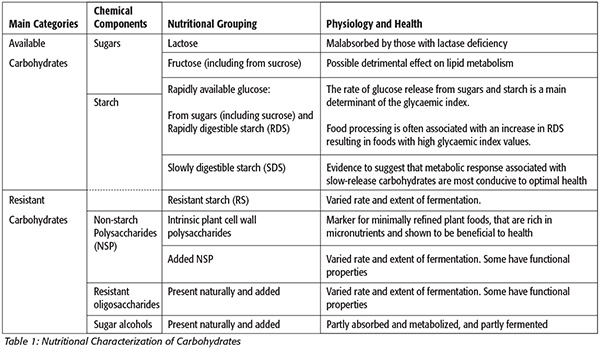 Carbohydrates typically represent a major component of most diets, though there has been a tendency to blame them, and particularly sugar, for rising levels of obesity seen in countries around the world. However, this is only one part of a much more complex story. In fact, the carbohydrates present in food have a broad range of physiological properties depending on their chemistry but, also importantly, on their physio-chemical characteristics, which are greatly influenced by food processing techniques. These characteristics can influence how carbohydrates are digested and utilized, and ultimately their impact on physiology and health. For nutritional purposes, dietary carbohydrates can be broadly grouped into two categories (Table 1).
Carbohydrates typically represent a major component of most diets, though there has been a tendency to blame them, and particularly sugar, for rising levels of obesity seen in countries around the world. However, this is only one part of a much more complex story. In fact, the carbohydrates present in food have a broad range of physiological properties depending on their chemistry but, also importantly, on their physio-chemical characteristics, which are greatly influenced by food processing techniques. These characteristics can influence how carbohydrates are digested and utilized, and ultimately their impact on physiology and health. For nutritional purposes, dietary carbohydrates can be broadly grouped into two categories (Table 1).
Available carbohydrates, which consist of the sum of carbohydrates that are digested and absorbed in the small intestine providing carbohydrates for metabolism
Resistant carbohydrates, which consist of the sum of carbohydrates that either resist hydrolysis by endogenous enzymes of the small intestine or are poorly absorbed and/or metabolized; those that reach the large intestine are potential substrates for microbial fermentation.
It is important to be able to characterize carbohydrates according to their likely nutritional properties so they can be researched effectively to identify how best to apply them for the prevention and management of diet related disease.2 Englyst Carbohydrates Ltd, based in Southampton, UK, specializes in the development and application of analytical methods for the characterization of dietary carbohydrates. These include assays for nonstarch polysaccharides (NSP), resistant oligosaccharides and starch digestibility fractions.
The principal resistant carbohydrates are the nonstarch polysaccharides from plant cell walls, which vary in their constituent profile depending on whether they are derived from fruit, vegetables or cereals. There are some naturally occurring, resistant oligosaccharides, such as fructans (fructose polymers) that are predominantly derived from onion-related vegetables and some cereals, as well as alpha-galactosides, which are found in legumes. In addition, there are a range of extracted and synthesized resistant carbohydrates that have been manufactured by the food ingredient industry.
The Importance of Categorizing Starch
From a physiological perspective, starch can be very interesting as the rate and extent of its digestion can vary with subsequent diverse metabolic effects. In its raw state, starch exists as granules that restrict access to hydrolytic enzymes, meaning that before processing, some ingredients are high in resistant starch (RS); the fraction escaping digestion in the small intestine. However, most food processing involving heat and moisture results in the dispersion of these granules, making the starch much more readily hydrolyzed so that the RS content is low for the majority of foods consumed. This process of making starch more digestible impacts directly on glycemic responses and postprandial metabolism.
Using methods developed by scientists at Englyst Carbohydrates Ltd, it has been possible to characterize the carbohydrate digestibility of foods further, with the division of available starch into rapidly digestible starch and slowly digestible starch (SDS); with the remaining portion being resistant starch.3 This characterization of starch provides a more nutritionally relevant stratification of foods in a way not possible by considering total starch values alone. Increasingly, it is being recognized that diets rich in slow-release carbohydrates can have benefits compared with those where rapid-release carbohydrates predominate. Indeed, in Europe the SDS component is the subject of a claim linking it with lower glycemic response.4
The significance of making the distinction between starch types based upon digestibility is a growing area of discussion. In 2015, The 12th European Nutrition Conference, hosted by the Federation of European Nutrition Societies in Berlin, Germany, explored recent advances in the understanding carbohydrate type and its impact on public health. At the event, scientists reiterated that diets that encourage only small changes in postprandial plasma glucose and insulin levels (i.e., diets enriched with SDS) are associated with a host of health benefits, stating that this subclassification of carbohydrates offers researchers a means of properly investigating starch’s role in postprandial blood glucose homeostasis.
As such, the application of analytical methods that can provide nutritionally relevant dietary carbohydrate characterization have potential to hugely impact on public health policies, ultimately helping consumers make more informed dietary decisions.
High-Performance Technology
Many of the methods developed and used for the characterization of carbohydrates involve multi-step techniques for extraction/isolation and hydrolysis of the relevant fractions. To minimize measurement uncertainty, whenever possible, internal standards are added at an early stage of the assay and chromatography is used for end point determination. The main techniques used are gas chromatography (GC) with flame ionization detection and high performance ion chromatography (HPIC) with pulsed amperometric detection (commonly known as high-performance, anion-exchange chromatography with pulsed amperometric detection).
GC systems enable analysis of multiple sugars rapidly. For example, they can provide detailed constituent NSP analysis with 11 sugars and elution of uronic acids in 4 minutes. While this makes GC a useful technique for this type of analysis, it requires derivatization of sugars to make them volatile and cannot measure carbohydrates larger than disaccharides.
Avoiding the need to undertake additional derivatization steps means that liquid chromatography is often the preferred choice for this kind of analysis. HPIC is generally considered the best option due to the greater selectivity provided compared to reversed-phase HPLC with refractive index, or UV/Vis detection techniques. HPIC is well suited to carbohydrate analysis using the principle of ion exchange, whereby hydroxyl groups on sugars are ionized in a hydroxide eluent and separated on a positively charged resin. The pulsed amperometric detection system with a gold electrode allows direct determination of carbohydrates and amino acids, with a high degree of selectivity.
For many years and several equipment generations, HPIC has proved a key analytical technique in the Englyst Carbohydrates laboratory. An important advance in this technology was the introduction of inline eluent generation, which makes it easy to instantly obtain a range of hydroxide eluent strengths and gradients while avoiding common reproducibility challenges from carbonate contamination. The most recent addition to the laboratory is the Thermo Scientific Dionex Integrion HPIC System, which combines the best features of HPIC in a compact format that is intuitive and straightforward to use. Coupled with a selection of analytical columns targeted at different applications, the HPIC system allows for the determination of a broad range of carbohydrates at high throughputs, without compromising data quality.
Adopting reliable chromatography systems that provide a high level of precision and selectivity for identifying and quantifying different carbohydrates is critical when developing and applying these types of detailed food chemistry assays. By taking into consideration carbohydrate characteristics with greater nutritional relevance, such as starch digestibility, it is possible to develop and promote foods with beneficial attributes and contribute towards healthier diets.
Dr. Klaus Englyst is managing director of Englyst Carbohydrates Ltd, which provides a nutrition led approach to the characterization of dietary carbohydrates. He earned his PhD at Cambridge University, focusing on starch digestibility and its metabolic implications.
References
Englyst, KN, S Liu and HN Englyst. 2007. “Nutritional Characterization and Measurement of Dietary Carbohydrates.” Eur J Clin Nutr 61(1):S19–39.
Birt, D et al. 2013. “Resistant Starch: Promise for Improving Human Health.” Adv Nutr 4:587–601.
Englyst, KN et al. 1999. “Rapidly Available Glucose in Foods: An In Vitro Measurement that Reflects the Glycemic Response.” Am J Clin Nutr 69(3):448–454.
EFSA Panel. 2011. “Scientific Opinion on the Substantiation of a Health Claim Related to “Slowly Digestible Starch in Starch-Containing Foods” and “Reduction of Post-Prandial Glycemic Responses” Pursuant to Article 13(5) of Regulation (EC) No 1924/2006.” EFSA J 9(7):2292.



